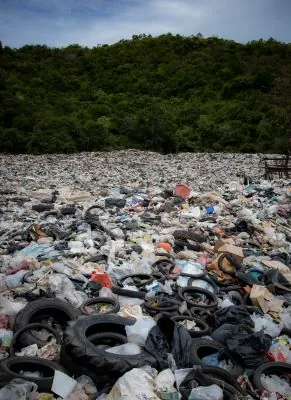What Happens to Rubbish?

UK households generate a lot of waste. In 2020, we generated over 27 million tonnes of it. You may not relish your trip to the bin, but do you ever think about where your household waste goes once it’s collected? Here’s what happens to rubbish.
Where does my rubbish go?
Once the council or waste management company collects your waste, it usually ends up in one of three places:
Landfill – According to government figures, 8.1% of all local authority waste (2.1 million tonnes) went to landfill in 2021/22. This is an increase of 0.1 million tonnes from 2020/21. Rubbish rotting in landfill emits greenhouse gases. To reduce the amount of waste going to landfills, the government aims to recycle 65% of municipal waste by 2035.
Incineration plant – Almost half of all councils use incineration. However, it’s a controversial waste disposal method. The process gives off toxic emissions and contributes to air pollution.
Recycling facility – Recycling is ideal when it comes to waste management. Unless you can avoid generating waste in the first place, that is. At recycling facilities, your rubbish is processed and turned into new materials or products.
But wait, let’s rewind. Before your rubbish ends up in any of these locations, it’s pre-treated.
Why is rubbish pre-treated?
So your rubbish ends up in a landfill, the incinerator, or the recycling plant. But what happens to rubbish even before that?
The answer is it’s pre-treated with a physical (like sorting), thermal, chemical, or biological process. There are several reasons why this happens including:
- To make it less hazardous
- To reduce its volume
- To make it easier to handle
- To make it easier to recover usable materials
What happens to rubbish at a treatment facility?
Once waste arrives at the facility, it’s sorted to remove any hazardous items or materials that could block machinery. It’s then shredded or ground up.
The waste is then screened and organic and inorganic materials are separated. Organic waste is composted or broken down through anaerobic digestion. The resulting material can then be used as fertiliser.
Materials that aren’t organic are sorted, shredded, ground, and heated, then separated into recyclable and non-recyclable materials. Any recyclables go to recycling facilities where they become brand new items. Plastic, for example, can become anything from plastic bottles to clothes, furniture, and building materials.
Non-recyclables are sent to landfill or incinerators.
Reduce your waste to do your bit
Now you know what happens to rubbish, it may make you more inclined to reduce your waste wherever you can. Preventing waste at source is an even better option than recycling. If you want to learn more about reducing your waste and your impact on the environment, check out the helpful tips on our blog.








